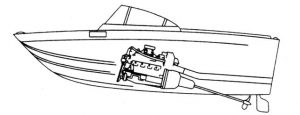Forespar's Point of View
Blogging About Life on the WaterSingle Engine Parking
It’s a narrow channel, and and a tight dock space. Worse yet, you’ve got a single engine, along with its single prop. Conventional wisdom tells you that you’re going have a tough time docking the boat  because of that single screw, without a lot of practice. Conventional wisdom is wrong.
because of that single screw, without a lot of practice. Conventional wisdom is wrong.
Yes, it’s easier with twins. You can back one, forward the other, spin the boat to line it up, both forward (or astern) and ease your way alongside the dock without touching the wheel. With a single many of us angle the bow toward the dock and add power while swinging the helm at the last second and hoping that we don’t bash the dock or stick the bow into boat ahead, which usually involves a quick pop of reverse power. Or come up a little too far away having to go around and try again
Don’t say you’ve never done any of the above. However, there are some simple rules that when applied will work:
Most important – the stern moves First! We think and feel the bow turning just like the car does, when in fact the boat turns by pushing the stern to one side or the other with pressure on the rudder, and forward motion pushes the bow around. If you keep this in mind (to the point that you don’t have to think about it), life with a single is easier.
Second – forget the throttle. Just put the boat into gear, preferably at idle. She will move, and you shouldn’t be in that much of a hurry.
Third – easy into the dock space. Pull up parallel to the dock space and a few feet away. Yes, parallel. Then, crank the helm all the way away from the dock, and slip the gear into forward for about two seconds. The immediately go to reverse for the same time interval. Repeat as necessary, and you’ll find your boat moving sideways into the dock.
Last, wind and current can help or hinder. And, you’ll want to compensate accordingly. Obviously, an onshore breeze is really nifty when it helps push you to the dock, An offshore breeze is going make you work harder to get there. Often, taking down canvas and covers reduces the windage, making things more manageable. Opening the windows reduces wind surface, sometimes to surprising extent. Current can be as, if not more, interesting, but usually solvable if you just make your starting point a bit up the current, and let it push you down into your space while you’re working the boat.
You don’t have be brave or too proud. If you’re having tough time, look over on the dock. When there are people there, many if not most will be happy to help if you just ask. And, most of the time, you can just pull away, go around and start over. You’ll get it in there.
And as in most things nautical, practice helps.
Mike Dwight